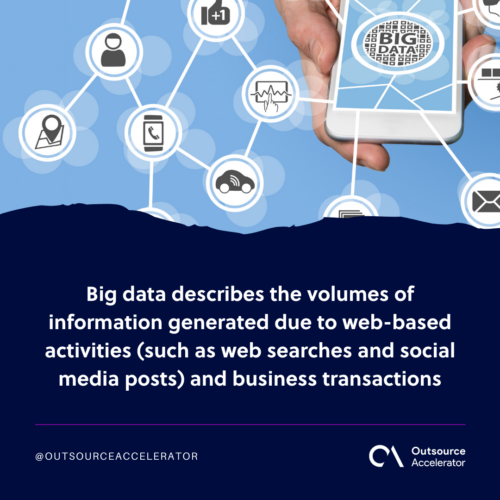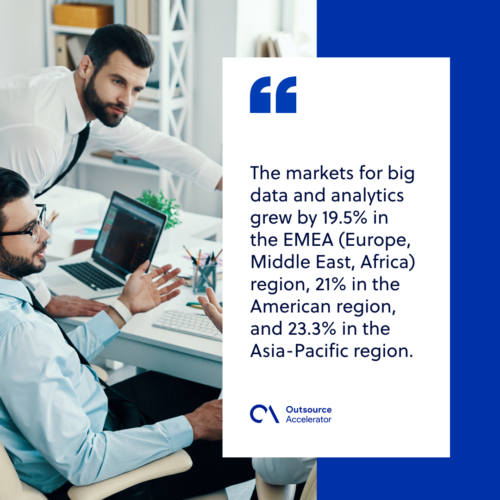Unveiling technologies and trends in the future of big data

Even in ancient civilizations, humans have attempted to use large amounts of information to get through work and make their lives easier. They realized combining different data sources gave them a competitive advantage over their enemies.
Today, we have big data. The term itself has been used since the early 1990s to describe the need to process increasingly larger data sets.
This article explores the future of big data and how it will shape businesses in the time ahead.
What is big data?
Big data describes the volumes of information generated due to web-based activities (such as web searches and social media posts) and business transactions. The term also refers to the algorithms and software tools used to process this data.
Big data is characterized by the following:
- High volume (multiple petabytes)
- High velocity (millions of events per second)
- High variety (multi-structured data)
Big data technologies can enable organizations to make better decisions by quickly analyzing large amounts of data generated from both traditional and non-traditional sources.
The amount of data under management is growing rapidly as businesses generate and capture more information about their customers, employees, and operations.

Top big data technologies in the modern era
Big data technologies are tools that help you collect, store, and analyze large amounts of data.
Today, these five technologies are rising to define the future of big data:
Artificial intelligence
Artificial intelligence (AI) is a technology that is used to create systems and machines that can think and act like humans. It can potentially change how we think about everything from healthcare, transportation, and education to entertainment.
AI systems can be trained to recognize patterns in large amounts of data and solve problems based on those patterns. In this way, they can perform complex tasks that would otherwise require human intervention, like identifying faces in photos or detecting fraud.
Artificial intelligence itself is dependent on big data, as its algorithms consist of patterns generated from large data sets.
SQL-based technologies
SQL stands for Structured Query Language, which is a standard language used to access and manipulate data in a database management system.
SQL-based technologies and databases can scale to handle large amounts of data by distributing the load across multiple servers. They also support complex queries that can be run against datasets containing millions of rows.
SQL-based technologies are especially helpful in parsing through unstructured data.
R programming
R programming is one of the most popular data science programming languages. It is used for statistical analysis, data mining, and visualizations.
The R language is widely used among data miners and statisticians for developing statistical software and data analysis.
R programming’s popularity has increased over the years as it has become easier to use and more powerful through extensions by third-party developers. It is one of the most popular programming languages in the world, allowing complex analyses of large datasets with ease.
Data lakes
Data lakes are large repositories of raw data that are not subjected to any form of data processing or analytics at the time of storage.
The idea behind data lakes is to store all of your organization’s raw data in one location so that it can be accessed and used at a later point in time.
Data lakes are often used to analyze unstructured and semi-structured data, such as:
- Log files
- Web server access logs
- Social media posts
The data is stored in the received form, making it easier for users to search through and analyze.
Predictive analytics
Predictive analytics is a subset of business intelligence and analytics that uses predictive models to forecast future events and help guide decision-making.
Predictive analytics is used to make informed decisions based on a set of rules and historical data. It helps to identify patterns that can be used to predict outcomes, improve business performance, and optimize operations.

Trends in the future of big data
The International Data Corporation, or IDC, has a positive outlook for the future of big data. The markets for big data and analytics grew by 19.5% in the EMEA (Europe, Middle East, Africa) region, 21% in the American region, and 23.3% in the Asia-Pacific region.
Big data is here to stay, and here are the trends that companies should take note of:
Democratization and decentralization of data
The democratization and decentralization of data are two trends that are transforming the way we use data. Data is no longer controlled by a few but instead has been made available to many.
The democratization of data has been driven by open-source software and cloud computing, which have greatly reduced the cost of accessing data.
Another driver is the availability of APIs that allow developers to integrate third-party software, thus, creating an ecosystem where data can be shared across applications and platforms.
This has led to new innovations in areas such as artificial intelligence, machine learning, and business intelligence.
Data migration to the cloud
The cloud has become the default choice for many companies looking to get more out of their data. It offers the ability to scale up or down, making it ideal for companies considering big data projects.
With the cloud, companies can store their data anywhere in the world, allowing them to access it as needed. As more companies look for ways to cut costs and gain access to advanced technology at a low price point, cloud computing will continue to grow in popularity.
Big data in government
Governments have been using big data for decades to support their missions. However, there are increasing expectations for the use of big data due to:
- Advances in technology
- Availability of more open data sources
- Increased awareness of the benefits
In addition, there is an increased focus on “open government” initiatives within federal agencies as they seek to make their data more accessible to citizens and other stakeholders.

Edge computing
The growth of AI and the IoT drives a need for data to be processed closer to where it’s generated. Edge devices are becoming more powerful but have limited processing capabilities and storage.
This is where edge computing comes in. It enables the analysis of massive amounts of data at the edge, close to its source. With this approach, companies can gain real-time insights from their data without sending it back to their data centers.
High demand for data scientists and CDOs
The demand for data scientists and Chief Data Officers (CDOs) is growing. Fortune’s ranking of the best online master’s degree programs in data science has seen 20% growth since 2020.
At the same time, we’re seeing a shortage of people with these skills. This means that companies need to think about how they will get the best from their employees, who may not have the right skill sets.
As the world becomes increasingly digital, the future of big data is not just a buzzword but a necessity to prepare for.







 Independent
Independent




